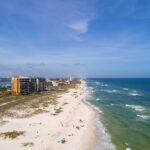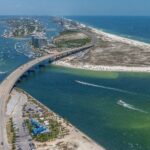Who Owns the Beach?
By Christopher Carter
Some 60% of Florida’s shoreline is privately owned, so knowing the line between public and private property is important.
 MIAMI – According to the Department of State, Florida has over 1,300 miles of coastline and over 650 miles of sand beaches. Some of that beachfront is privately owned (about 60%), while the rest is state, county or city controlled. For decades, there have been ongoing questions over who can use certain stretches of beach along Florida’s Atlantic and Gulf coasts.
MIAMI – According to the Department of State, Florida has over 1,300 miles of coastline and over 650 miles of sand beaches. Some of that beachfront is privately owned (about 60%), while the rest is state, county or city controlled. For decades, there have been ongoing questions over who can use certain stretches of beach along Florida’s Atlantic and Gulf coasts.
Today’s discussion centers on beaches directly on the Atlantic Ocean and the Gulf of Mexico and what might be considered “using” a certain stretch of sandy shoreline.
I am not an attorney. For interpretation and application to specific circumstances, you must speak with a Florida-licensed attorney.
Let’s start with the Mean High Water Line (MHWL), an important measurement for beachfront property lines. Florida Statutes establish the MHWL as the average height (elevation) of high tide saltwater at a specific location on the shore over a 19-year period. Most of us who go to Florida beaches think of a high-tide mark as how far water comes onto the beach (distance) at high tide on any given day. It’s the same basic concept, but there are different ways to look at it.
The MHWL measurement uses an average because beach sand moves around every time the tide goes in or out and whenever a tropical storm or hurricane lands.
The simpler version of this has become the “wet sand/dry sand” public interpretation of beach access and use because Florida holds all land seaward of the MHWL (high tide line) in trust for use by Florida residents and visitors — the public.
On coastal Florida beaches, sand that has been wet from normal ocean or gulf tidal action is always public access and use; dry sand can be either public or private.
Remember that during low tides, some of the dry sand close to the water was wet during the last high tide, so the “wet sand/dry sand” rule isn’t literal to current conditions all the time. It is the average high tide line (MHWL) that applies whether that stretch of beach is currently experiencing a low or high tide.
However, the determination of public or private is not quite that simple. It also depends on how far individual beachfront property lines extend toward the water.
Privately owned beachfront property can extend to the MHWL, including all the dry sand. However, not all private property lines extend to that average high tide line. A specific property’s recorded deed has to be examined to see if it does.
Lot lines only extend to vegetation lines, not all the way to MHWL.
 In these aerial views, the upper property extends all the way to the MHWL, while the lower one does not. In very simple terms, the owners of the upper property may be able to prevent the public from walking along the dry sand between their house and the high tide line, which is deeded private property in this case.
In these aerial views, the upper property extends all the way to the MHWL, while the lower one does not. In very simple terms, the owners of the upper property may be able to prevent the public from walking along the dry sand between their house and the high tide line, which is deeded private property in this case.
The owners of the lower property do not have the same right to potentially exclude public use because their property does not extend all the way to the water.
In addition to individual residential owners, other entities may be able to enforce private beachfront rights when their properties extend to the MHWL:
– Hotels, restaurants, and other businesses
– Condominium associations
– Private clubs
– HOAs
The county (or incorporated city) in which a property is located has the authority to establish, recognize, and provide enforcement procedures for individual property rights, including the rights of beachfront property owners to control who can walk or sit on the dry sand in front of their properties.
Counties and cities also own and maintain large stretches of dry sand beaches for public use and enjoyment. Everyone can walk, sit, play, and swim wherever they like. In these areas, private beachfront lots end at the vegetation line between dry sand and the property’s private yard, “upland” from the public beach.
And then there is “customary use”
In 1974, Florida’s Supreme Court recognized the concept of public customary use of privately-owned beachfront. The Ccurt stated, “If the recreational use of the sandy area adjacent to the mean high tide has been ancient, reasonable, without interruption and free from dispute, such use as a matter of custom, should not be interfered with by the owner.”
Attorneys tell us that “the sandy area adjacent to the mean high tide…” means the dry sand beach, and the use of the word “ancient” is considered to be 50 to 70 years old. Pretty good chance that people have been walking along any given stretch of Florida’s sandy shoreline since at least the 1950s.
Note that customary use can only apply to private beachfront properties that extend all the way to the MHWL. Those properties whose lot lines do not extend onto and include the beach sand are not affected by customary use because they do not own the dry sand.
Under the 1974 court ruling, local cities and counties may establish recreational customary use ordinances for stretches of beach that include private property, acknowledging previous public use and protecting future public use. If beachfront private property owners dispute the public’s customary use of “their” beach, they can challenge that use in court.
 Now that we know a little bit about the MHWL, wet sand/dry sand, lot lines, and customary use ordinances, how does all of that relate to things in actual practice?
Now that we know a little bit about the MHWL, wet sand/dry sand, lot lines, and customary use ordinances, how does all of that relate to things in actual practice?
– When walking onto the sand from the landside, look for signs indicating who has authority over the beach. This could be the state, county, city, a private entity, or it may fall under a local customary use ordinance.
– If you are walking along the shore and come to a “private beach” sign or barrier, walk across that stretch close to the water. Respect the sign, though later, you may want to verify its claim with local authorities.
– Don’t even think about planting your beach chairs, towels, and umbrella on a beach you know is private. It is most often beachfront hotels, owners’ associations, and membership clubs that will actively enforce private beaches and lot lines extending to the MHWL.
– When a private property extends all the way down the dry sand to the high tide line, many (most?) individual owners understand and accept recreational Customary Use ordinances and public use. Beachfront hotels and owners associations don’t usually prevent public beachgoers from walking along the beach, though may only allow hotel guests and association members to sit and relax on their dry sand.
Florida has some of the most beautiful beaches in the world. East Coast beaches are different from West Coast beaches; Northern Florida beaches are different from South Florida ones. Enjoy, explore, appreciate, and respect all of them.
Florida has 67 counties, 35 of which are on the coastline. All residents and visitors should know how beach use is handled in our state.
© Copyright 2024 IslanderNews.com
